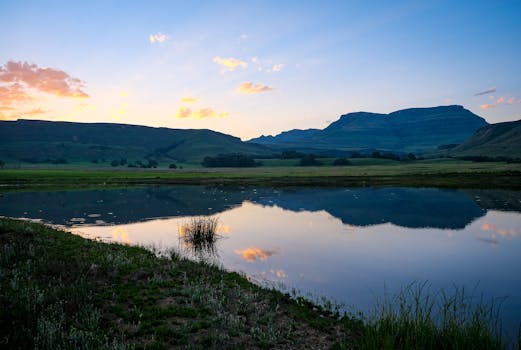Exploring the Drakensberg Mountains, South Africa

South Africa's Drakensberg Mountains, a majestic range that stretches over 1,000 kilometers, offers a captivating blend of natural beauty, rich history, and thrilling outdoor activities. Known locally as uKhahlamba, meaning "Barrier of Spears," this UNESCO World Heritage site is renowned for its dramatic peaks, verdant valleys, and ancient rock art. Whether you're an avid hiker, a history enthusiast, or someone seeking tranquility in nature, the Drakensberg Mountains promise an unforgettable experience.
Geography and Climate
The Drakensberg Mountains span the eastern part of South Africa, forming a natural border between KwaZulu-Natal and the Kingdom of Lesotho. The highest peak, Thabana Ntlenyana, reaches an impressive 3,482 meters. The region's climate varies significantly with altitude; lower elevations enjoy a subtropical climate, while higher altitudes experience cooler temperatures and occasional snowfall during winter.
Summer months (November to February) bring warm weather and afternoon thunderstorms, ideal for lush landscapes but require caution during outdoor activities. Winter (June to August) offers clear skies and cooler temperatures, making it perfect for hiking and sightseeing without the summer heat.
Flora and Fauna
The Drakensberg Mountains are home to a diverse array of flora and fauna. The lower slopes are characterized by grasslands and savannas, while higher altitudes boast alpine vegetation. This unique biodiversity supports numerous endemic species.
- Birdlife: The area is a birdwatcher's paradise with over 300 species, including the endangered Bearded Vulture.
- Mammals: Visitors may encounter elands, baboons, and even the elusive leopard.
- Flora: Indigenous plants like the Drakensberg cycad and various protea species add to the region's botanical richness.
Activities and Adventures
The Drakensberg Mountains offer a plethora of activities for adventure seekers. Hiking is undoubtedly the most popular activity, with trails ranging from easy walks to challenging treks. The Amphitheatre hike in the Royal Natal National Park is particularly famous for its stunning views and the Tugela Falls, the second-highest waterfall in the world.
Other activities include:
- Rock Climbing: The Cathedral Peak area offers routes for climbers of all skill levels.
- Fly Fishing: Crystal-clear streams provide excellent opportunities for catching trout.
- Horse Riding: Guided tours offer a unique way to explore the landscape.
Cultural Significance
The Drakensberg Mountains are not only a natural wonder but also a cultural treasure trove. The San people left behind an extensive collection of rock art that dates back thousands of years. These paintings offer insights into their daily lives, spiritual beliefs, and interactions with nature.
One notable site is Game Pass Shelter in Kamberg Nature Reserve. Here, visitors can view well-preserved paintings depicting hunting scenes and shamanic rituals. Guided tours provide valuable context and enhance the appreciation of these ancient artworks.
Accommodation and Travel Tips
A variety of accommodation options cater to different preferences and budgets. From luxury lodges to budget-friendly campsites, there's something for everyone. Popular choices include:
| Accommodation Type | Description | Examples |
|---|---|---|
| Luxury Lodges | Offer premium amenities and stunning views. | Montusi Mountain Lodge |
| Mid-Range Hotels | Comfortable options with good facilities. | Cathedral Peak Hotel |
| Campsites | Affordable options close to nature. | SANParks Campsites |
When planning your trip, consider these tips:
- Packing: Include layers for varying temperatures, sturdy hiking boots, and rain gear.
- Permits: Some areas require permits for hiking or camping; check in advance.
- Guides: Hiring local guides can enhance your experience by providing valuable insights into the region's history and ecology.
The Drakensberg Mountains offer a unique blend of natural beauty, adventure opportunities, cultural heritage, and biodiversity. Whether exploring ancient rock art or embarking on thrilling hikes, every moment spent here leaves an indelible mark on visitors. Sustainable tourism ensures that this remarkable region remains unspoiled for future generations to enjoy.